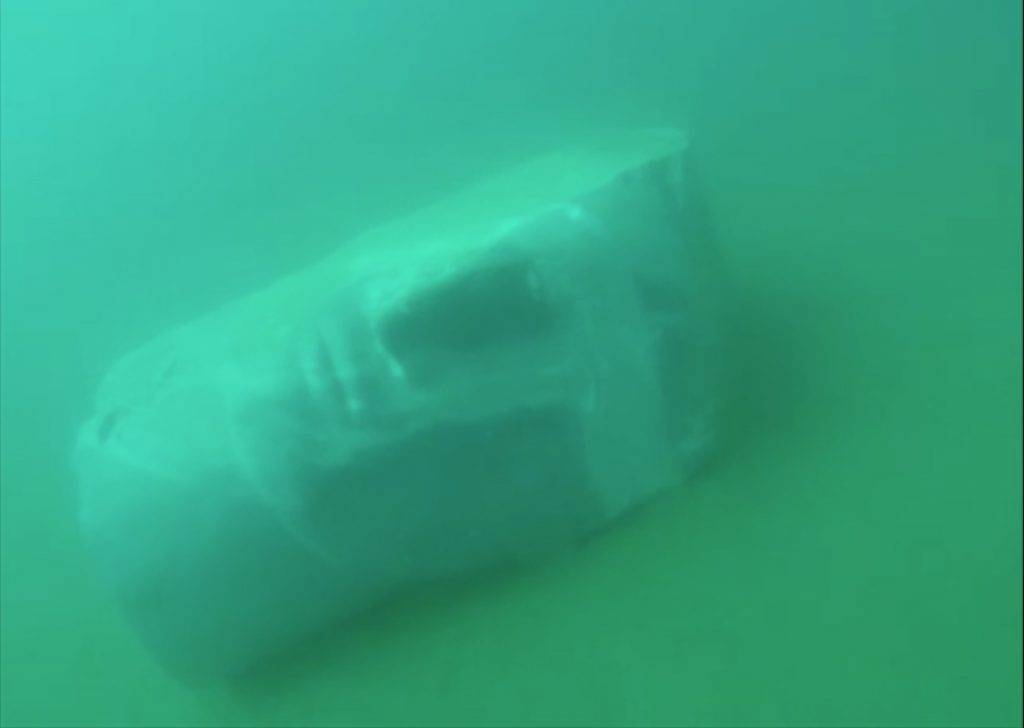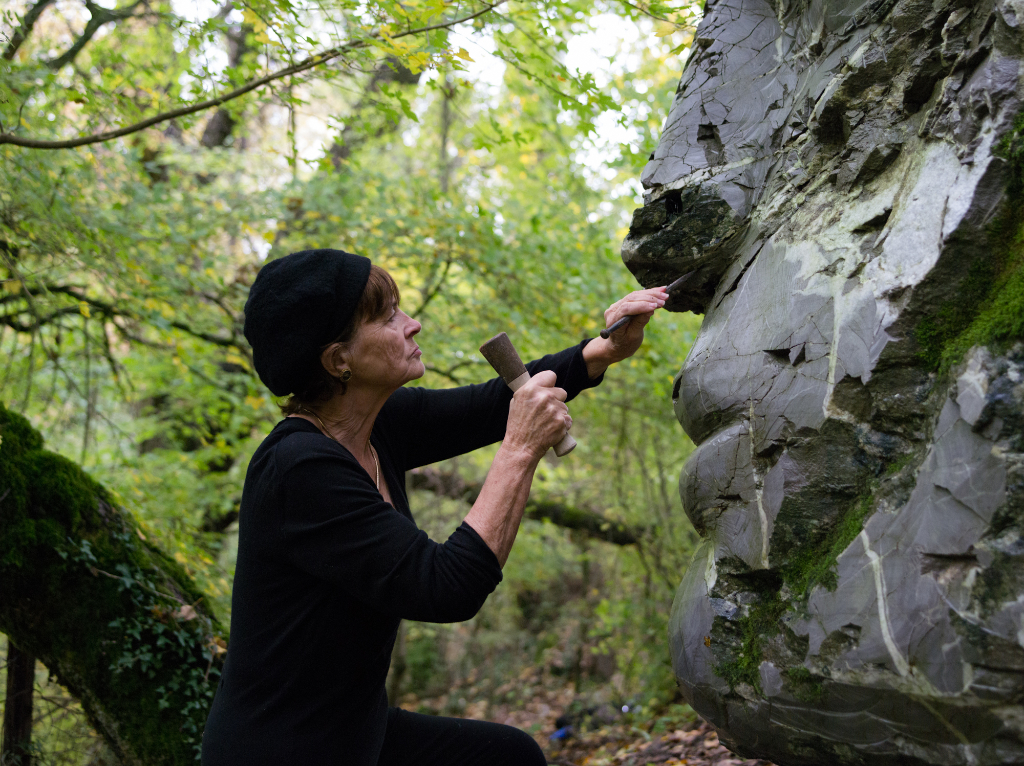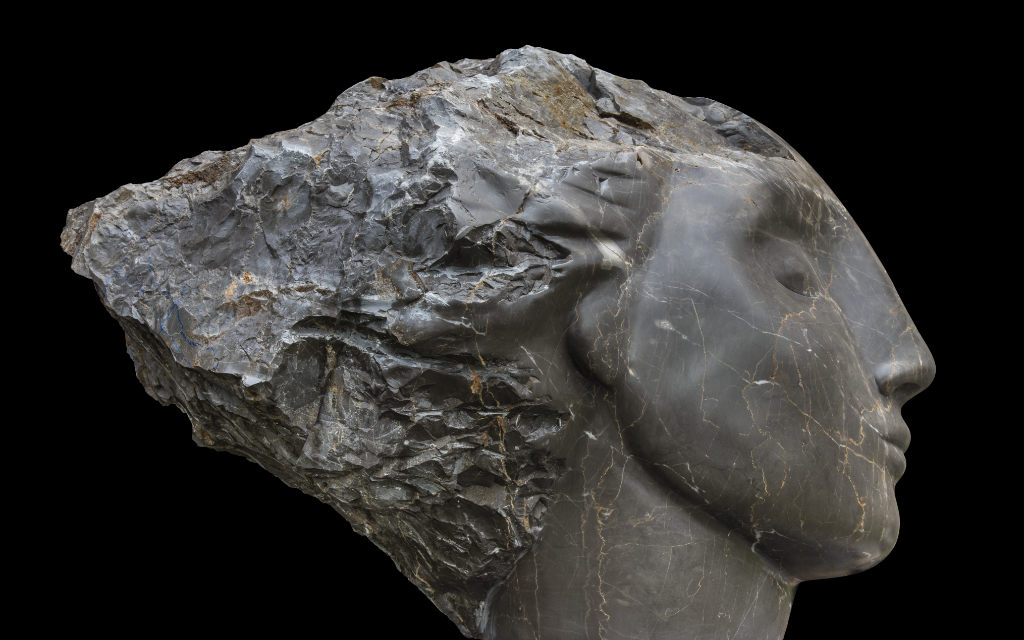Text by Anne Murray

What happens when a human addresses a piece of stone? An essential question in Emily Young’s ongoing research as an artist. With stone as her main medium, the elements of perspective of the stone and a consistent dialogue with it, have become a focus for her over time. She explains that initially her perception of the stone and its relationship, began with a response to the aesthetic qualities of the stone and later evolved into a discourse, a relationship not unlike the sensual and intimate connection between two lovers, tête-à-tête, in quiet conversation.
Sometimes they don’t want to play, they don’t want to be carved. It’s not that it’s not working, it’s that I’m not happy about it. Gradually I was finding that I was having, [something] almost like a love affair. I was listening to the stone, as to a baby perhaps, or a friend – you want to find out what they are bringing to the table, Young explained.
Remarking on origins, a billion year history of materials which we share with stones, Young’s curiosity about the material qualities we have in common with the stones led to more questions. Young cites a few of these, how did I get to be here, having a conversation using my hands, with a piece of stone, which is maybe billions of years old?, What does this stone want from me?
I reflect on my own work, Fata Morgana, research into the life, friendship and love experienced by a stone and a philosophical conversation with it, a record of ‘now’ in continuum, the stone recording my relationship with it and the art which I projected onto it. I realise what I have in common with Young and also how we each approach the stone in a different way.
As humans, we often see the ‘other’ donning human emotions, characteristics, and feeling onto it, an essential approach to how we address something from our own perspective, while trying to imagine its own perceptions without truly knowing what its experience is definitively. Young’s work puts a face on the stone, gives it a way to regard us, to stare directly into our own perceptions, as a magnifying glass to the human experience perceived from the perspective of the stone.
Face pareidolia is a phenomenon where humans see faces in nebulous forms, a perception which artists take a wonderful advantage of in their visionary works. Young literally puts a face onto the stone, permitting us the privilege of interacting with the stone with the understanding she feels as she works with it in a silent discourse of corporality, a dance, each knowing that one is made of the same substance as the other.
Young’s reverence for the stone emerges in her responses, I’m honouring the earth and I’m honouring the fact that it is very much older, very much quieter than me, but it is alive. It has an electromagnetic quality. All those particles in it have agreed to stay together and that is the basis of physical reality. She describes the stones as a temple of time, virtually indestructible, holding a long history, her work becoming a part of this endurance, lasting beyond humanity itself, because of its resistance to radiation.
A billion years is a long time, but in that period of time, maybe we won’t be here anymore, but I like the fact that they will find these sculptures. They won’t look like sculptures, they’ll just look like lumps. They’ll say, “Hang on, what is this rock?” There’s a slim chance that somebody might recognise it and say, This is humans. Humans made this. Apart from just wreaking havoc, they also – maybe this is what they looked like, maybe this is what they felt. Many things will disintegrate, not many things will endure so it’s a poetic notion, it really is, explains Young in an email response.



Young describes the Earth as a museum; thus, inherent in its qualities, one can surmise that it is a place of remembrance, her works echoing the past, while being continually shaped by the atmosphere and weather patterns, especially her works conceived for the outdoors.
In her process she is very particular about which stones she carves, Young extrapolating, says, I feel slightly towards them as if they’re my children. I spend quite a lot of time finding the stone, looking at it, having a cup of tea with it, and then washing it, and then walking away and coming back to it. It slowly sort of unpacks itself. This is who I will be to you, if you want. Quite a lot of anthropomorphism that goes on. There is actually no other way to look at nature but anthropomorphically.
Young reflects often on Earth’s history and our human relationship with the Earth. It goes back slightly to this thing about stone carvings. The oldest things we see on earth were made of stone. I’m just part of that. What I’m really interested in is that I did go back and look at all of these things that people have made – Palaeolithic art works, and then going back and looking at it. Why did they choose that shape? What it must have been like for people, explains Young.
Young creates stone works as heads, torsos, sun discs, for both indoor and outdoor settings. She was commissioned to create work along with several other artists, to block trawling, off the coast of Tuscany, which endangers marine animals, and unsettles the delicate ecosystems that we are reliant on to keep our Earth’s body in balance. Her works literally were installed as barriers, which kept trawling from happening, but the works are invisible as structures underwater, hard to find and observe.
They become the epitome of human sentinels, guarding the Earth with their sculpted forms, standing up as humans have across the world to save trees, seas, and landscapes. Her works echo the famous image of a man in front of a tank standing solo against the massive force of a machine from footage of the Tiananmen Square Massacre in 1989. They embody our altruism and represent our human ideals, the noble goals and philosophical visions we might hope to be known to future generations, or to aliens arriving long after we have departed in one way or another.
The Weeping Guardian is one of these works at the bottom of the sea, its name already stirring our emotions. Influenced by eastern thought, Young explains, The Buddhist thing about paying attention, about being very attentive to what is going on. We don’t need to listen, it’s what you’re feeling about being alive – that’s really what I’m asking the stone to allow me to put into it. And I never know what’s going to be inside the stone.
For example, the piece – I call him the weeping guardian – from the outside, its very white and you don’t know what you’re going to find inside, and there’s this big black tear so I call him the weeping guardian. I knew there were going to be sentinels and they were going to guard that bit of the coastline.
Young was born in London to a family of artists and clearly has nurtured an activist spirit and attention to details of her environment both spiritually and viscerally. Her conscientiousness comes through in her willingness to leave her sculptures at the bottom of the sea in order to protect marine environments, her sculptures becoming home to corals and other animals as they disintegrate over time returning gradually to the ocean’s bed, one grain at a time.
Her words echo in my mind as I reflect on our human lifetime versus the endurance of stone, she says, I don’t want our human detritus to be the only thing that’s left around. Indeed, her work becomes an offering to the sea, to allow it to reshape our human detritus, to deface it, while embracing it as a new place of exploration, a new home for the tiniest of creatures, living out their lives, until they too, become just a grain of sand in a vast ocean of existence. The existential element is not lost, in this eloquent vision.






